Above:Reproduction of Local Weave Culture by Miyang, the Master of Paiwan Ground Weaving Machine.
Miyang is already 71 years old. From her palm, you can trace years of hard work passing weaving threads between her hands to this day when she still sits with a straight back on the floor as she works on her traditional weaving loom. The sound is strong and powerful and Miyang tramples on the pedals, fixes the heads, and operates the shuttle by hand as she weaves fabric with the Paiwan community’s pattern. I used to think it was old-fashioned to sit on the ground and weave, but after I got older and experienced, I finally realized what a precious culture I’ve had in front of me all along,” Miyang softly says with profound meaning.
After World War II, in compliance with national policies, many tribes moved down from the mountains, but as the ancient tribes moved down to the plains in 1953, the customs of the tribes also gradually changed, the traditional lifestyle of men hunting and women weaving was seen as symbols of the past by the modern civilization, not to mention the time-consuming and arduous local loom technology.
Miyang has grown from a long line of skillful weavers with knowledge handed down from generation to generation and as a child, she used to “play” weaving with her mother in the mountains. However, due to the ease in obtaining clothes in the cities, the weaving concept within the tribes and its people have been also influenced although women can still weave, their skills have largely been restricted to the use of flat looms with twill weaving techniques producing quilts, back straps and long trousers while the complex and time-consuming weaving techniques such as inlay weaving have become much less familiar. “At that time, I also thought that weaving clothes with the traditional loom was a very uncivilized method, so I didn’t like it.” says Miyang candidly.
Miyang has been drawn towards western design since a child, by relying on her talent and hard work she managed to pass and achieve the top grade as a women clothing technician and proceeded to work in an export clothing factory where she designed and produced elegant western dresses. Through constantly thinking of new ways to produce innovating designs Miyang suddenly had an idea: “My culture is so rich in patterns so why not apply it to a dress?”
Miyang used the Paiwan patterns and beaded embroidery as an embellishment on an evening dress, at the time she was unaware of the enthusiastic reaction she would later receive from her clients, “this truly left me astonished, through this response I finally realized how abundant and rich my culture really is.” Before she always considered fashion to be defined by western clothing design, but through this experience, Miyang started to reexamine the Paiwan people’s traditional techniques of weaving and embroidering and she found how precious her own culture is, but since nobody was learning the traditional techniques, it would soon be lost and forgotten.
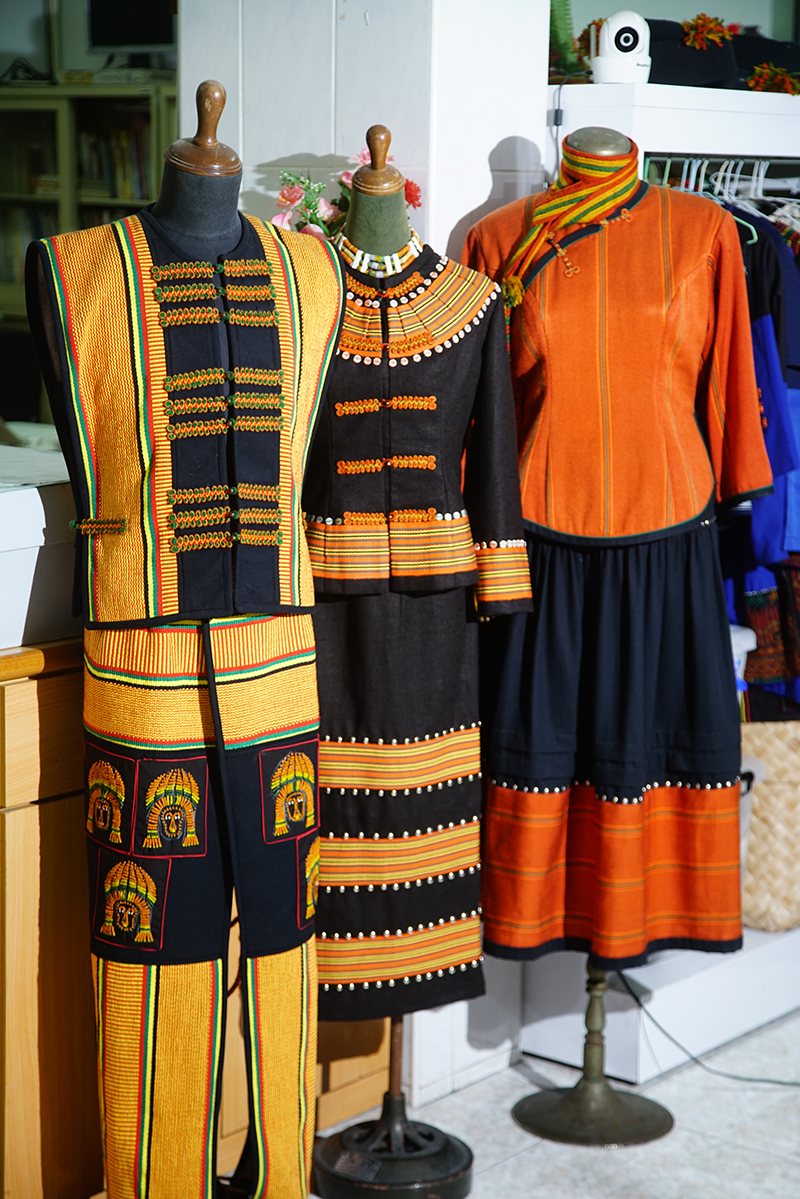
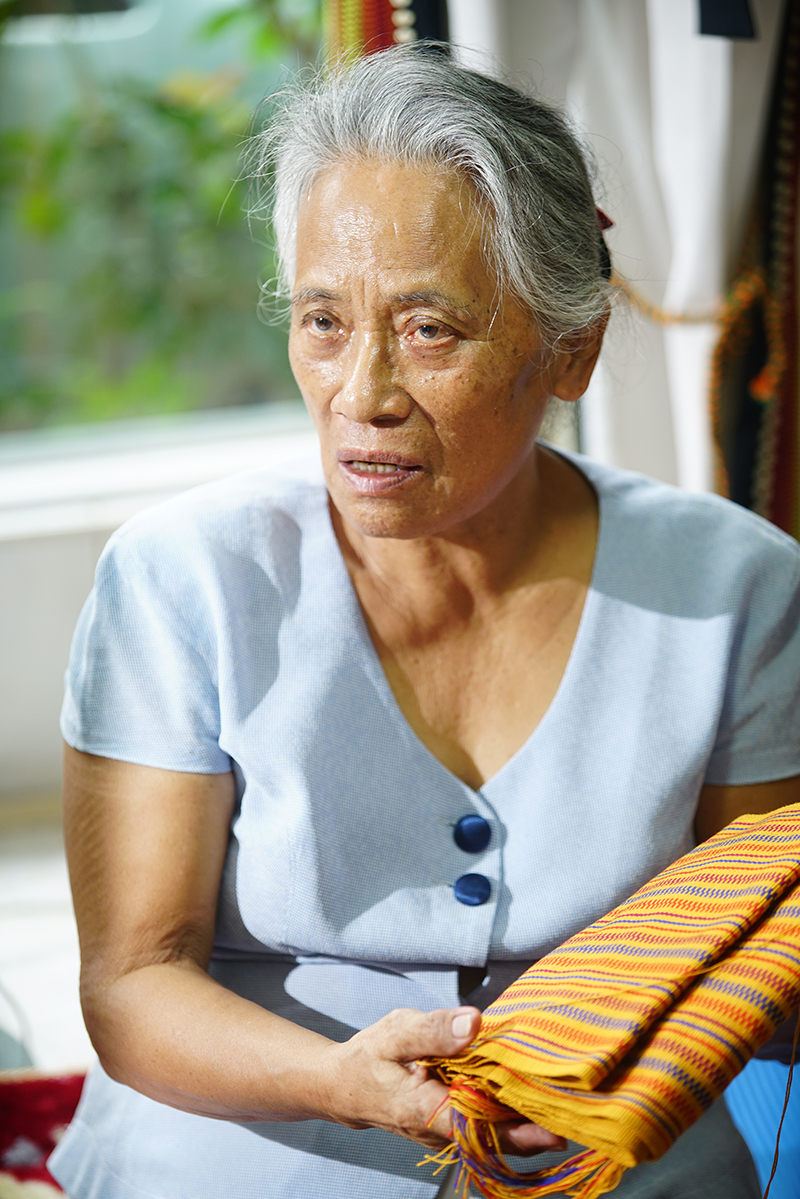
With Diligent Learning, Restoration and Weave Teaching of Traditional almost Extinct Inlay Weaving Technique by Miyang
With Father’s Guidance
Retrieving the Lost Inlay Weaving Techniques
Miyang was determined to start learning to weave with the local looming method; she was nearly 50 years when she decided to learn from the elder Tjinuai, the only one left within her tribe that still knew how to weave by using the traditional techniques. Miyang made use of her holidays to learn from Tjinuai traveling back and forth to the community; however, her teacher only knew the basic skills of the flat looms and twill weaving techniques. The inlay weaving knowledge to produce complex patterns had long been lost.
“As a man and according to our tradition, my father was not allowed to touch women’s weaving tools, let alone weave; however, since he was a child he would be able to watch grandmother weave and memorize her techniques. My inlay weaving techniques were taught to me by my father.”
Her father who had an eye for details and a great memory remembered grandmother’s songs, her weaving methods, and various weave patterns, a knowledge which he passed on to Miyang. By examining the fabrics left by her grandmother and through the guidance of her father, the two worked together to retrieve the seemingly lost methods and patterns of inlay weaving that were only stored in her fathers memory, “there were many patterns I’ve had never seen before and I could only follow the instructions from my father and repeat the designs until it was exactly as he remembered it, only then would my father be satisfied and nod with approval”.
Her father cared so much about her family weaving over the continued tradition and inheritance of the family weaving techniques, so when Miyang agreed to come back to the community and learn from the elders, nobody was happier than her father. As long as she would practice at home, her father would sit beside her and guide her and use the leftover threads to wove red, yellow and green braided ropes. “At that time father weaved a lot. I sewed some of it into an evening dress, but there is still a lot left!” Miyang recalled with a smile as her eyes revealed a longing for her father. For Miyang, these braided ropes are the memory of her learning to weave together with her father and they represent a father’s love and expectations for his daughter.
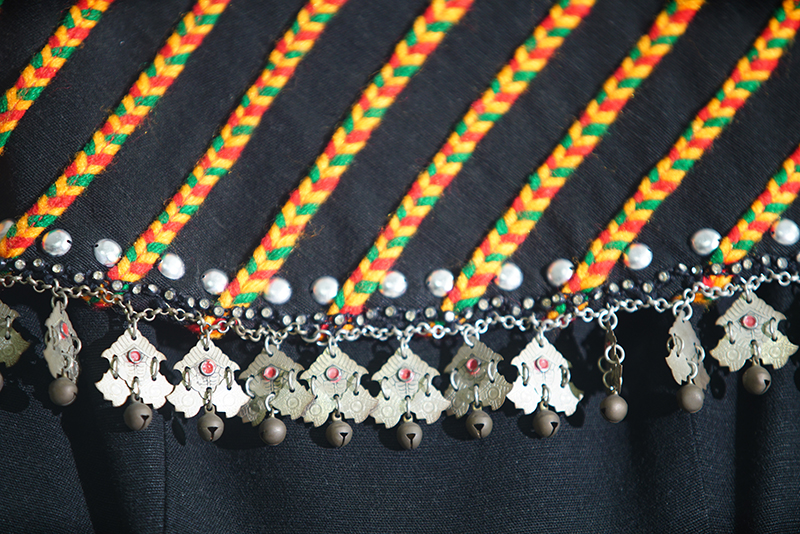
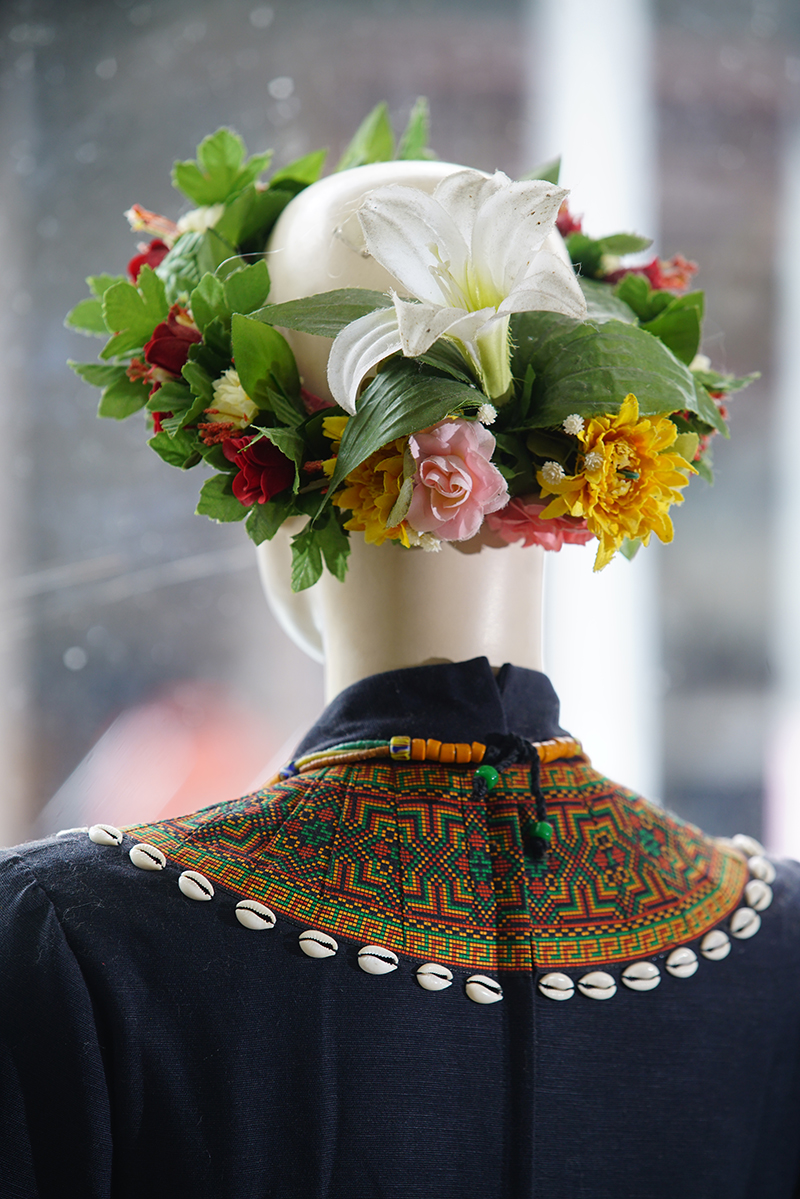
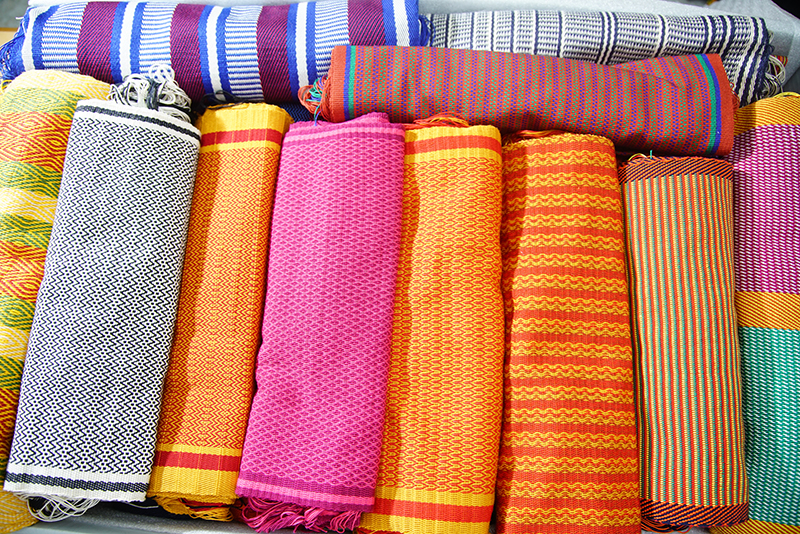
Fabrics and Weave Products at Miyan’s Studio Presenting the Rich Paiwan Culture.
Patterns Knowledge, Methods, and Rules
Left by Ancestors
“A Paiwan woman is responsible for the clothing of the whole family,” Miyang says, just as hunting is a man’s job, weaving is a woman’s responsibility and obligation. The clothes worn by the family, each and every garment is weaved out by the woman of that family.
The various patterns on the clothing represent the cultural knowledge inherited from the ancestors and the work that women are responsible for. “We don't have a written language, so the patterns are like messages left by our ancestors, teaching us methods and rules” as she explains that except for weaving, women also need to farm in the fields. The sand pattern symbolizes the technique of tilling the fields and how to protect the slopes when they are cultivated. The tooth patterns mean health as the ancestors believed that women were responsible for the health of the family, and the people also believe that a person’s health is closely related to the condition of the teeth.
Different from using the repeating patterns of plain weave and twill weave, the traditional techniques of inlay weaving enable the fabric to be embroidered like a painting filled with gorgeous and colorful complex patterns, which tests the weaver’s ability to compose warp and route while being careful and patient. For important ceremonies such as birth, marriage, funeral, and so on, the people wear the most beautiful and best-looking clothes made with inlay weaving.
“I don't know why the outside world says that our inlay weaving technique is only used in the production of mourning clothes, but the trousers, and skirts that are generally worn are also often produced using this inlay weaving method,” Miyang says helplessly. In the tradition of the Paiwan people, the death of a loved one is extremely prudent, so they will put on the finest clothes to see the person off. These gorgeous clothes must be made by the inlay weaving technique, as it symbolizes that the tribe places great importance and seriousness to the matter; however, this does not mean that weaving is only limited to funeral clothes.“ It is not just for mourning; it’s for happy occasions as well!” Miyang says.
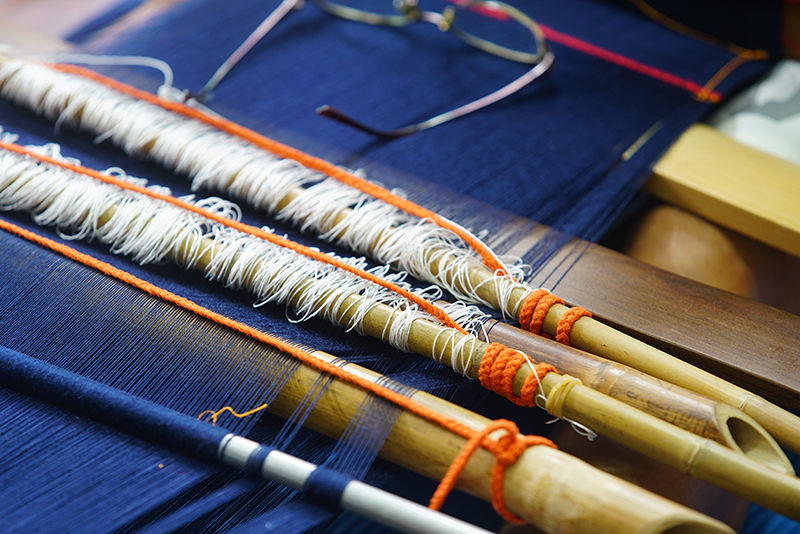
There are various types of weaves but Inlay weaving is almost extinct. In order to represent this important weaving technique of Paiwan, Master Miyang from Kuljaljau Maljeveq opened courses for community residents.
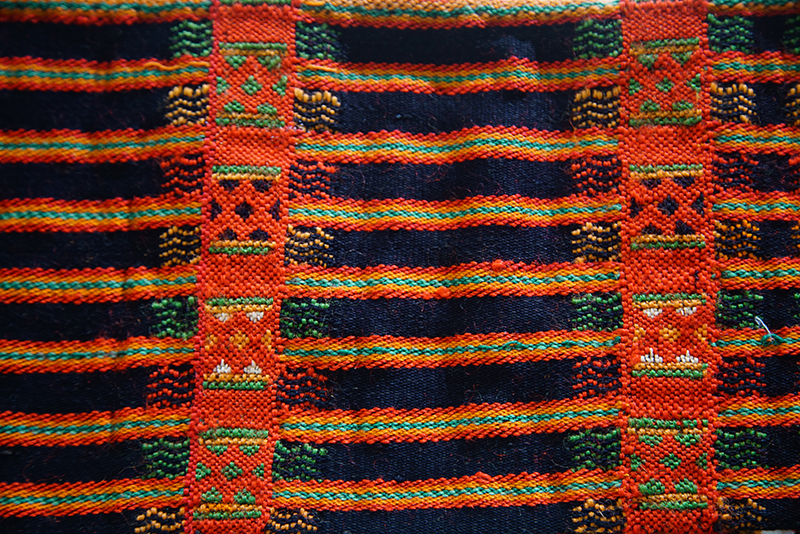
It shows how Miyangs Grannie is weaving a pair of trousers for her father with Inlay weaving.
Passing on without Stopping
Reproduce the Traditional Inlay Weave Pattern
Not only is Miyang retrieving traditional weaving techniques, but she also incorporates her expertise in design to improve Paiwan’s clothing while combining it with traditional weaving patterns so as to give a new life to the traditional culture and allow it to adapt to the new era. She believes that to integrate tradition and modernity, one still needs to understand the meaning and the rules the ancestors engraved in the patterns and appropriate pattern and embroidering depending on the object and the purpose of the garment. For example, the pattern representing health can be used on all kinds of clothing to symbolize the meaning of blessed health while the sun pattern and the human head pattern are reserved for nobles and above. “You can weave it, but you cannot casually wear it,” Miyang says with a smile when teaching her students. She requests that they all understand each pattern meaning to avoid misuse.
Miyang returned to the community in 1994 and established a workshop besides concentrating on passing on the Paiwan traditional ground weaving technique. She also teaches classes at community colleges in Kaohsiung and Pingtung. Her classes combined all ethnicities and genders. As long as you have the heart to learn, she is willing to teach you. “But the real problem lies in time required. It took me almost eight years to teach about seven students to be familiar with the basic patterns of plain and twill weaving and for the complicate inlay weaving, much longer time is expected,” said the concerned Miyang.
Although Miyang rediscovered the traditional inlay weaving techniques, she still has not had enough time to weave a pair of pants for her own family. “In a six-hour working day, you can weave about 0.8 cm, so it takes about a year.” Miyang understands that she cannot slow down when it comes to passing on the weaving knowledge. For next year, she is already planning to push herself to gradually reproduce the traditional weaving pattern. At present, Miyang has compiled 20 patterns of Paiwan plain-woven and twill weaves, which are expected to be published at the end of 2019, leaving a precious record of inlay weaving techniques. Although the traditional weaving patterns have not yet been arranged orderly, based on her research, there are at least 20 patterns.
“I’m racing against time. I’m afraid that I may not be able preserve the valuable cultural assets before they lose,” Miyang said with a concerned smile but she still sit straightly and continued weaving.




